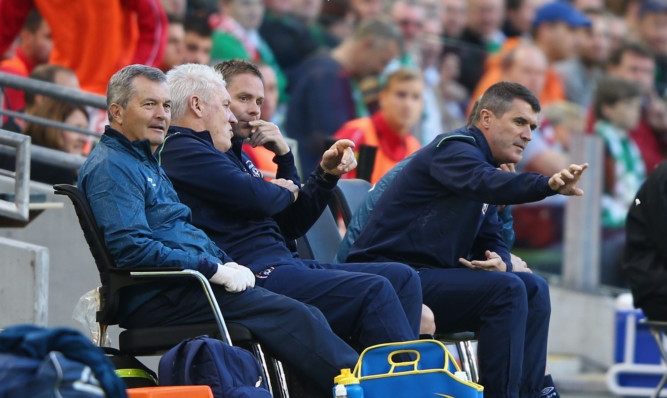
Roy Keane has revealed Sir Alex Ferguson used to hate him representing the Republic of Ireland but would have loved it if he had played for Scotland.
When Ferguson was Keane’s boss at Manchester United, the midfielder claims Ferguson would put pressure on him not to play in certain games for his country, particularly friendlies.
Of course, Keane retired from international football after the controversy during the 2002 World Cup in Japan under Mick McCarthy, but he returned to the scene for the 2006 World Cup qualifying campaign when Brian Kerr was gaffer.
That decision didn’t go down well with Ferguson.
Yet, Keane used to get irked when he’d watch the likes of Darren Fletcher get every encouragement going about playing for Scotland.
Keane who will face the Scots next month for Republic of Ireland in the Euro 2016 qualifier – said: “Ferguson is all about power and control. That’s why he has criticised some of the players who helped him win trophies at Manchester United. It was just ridiculous to criticise.
“I was constantly under pressure from Ferguson not to play in certain games for my country. And if I did play then he wouldn’t speak to me for days when I came back. I had all that nonsense going on.
“Maybe if I was Scottish he might have been a bit more relaxed about it. Because I know he’d say to them ‘Yeah, go and enjoy it’ but maybe it was a compliment to me because he needed me for United the next Saturday. He didn’t wave me off, far from it.”
Keane has his issues with Ferguson but, in terms of management style, would rather be like him than someone such as Harry Redknapp.
He admitted to being moody with players and rarely offering them an arm around the shoulder.
But he insisted that’s the way footballers would rather have it and stressed: “I don’t want to be pals with people on certain days. That’s just part and parcel of being a bloke.
“From my time at Sunderland and Ipswich some players have given a fair reflection. But this perception that I was coming in every day and kicking chairs. Nonsense. Don’t think for one minute I was behaving like a madman.
“Everything is about getting the balance right. You don’t want people to be cosy with you. Do you think I was cosy with Brian Clough, Jack Charlton or Alex Ferguson? No. Sometimes that coldness is a good thing.
“Other managers such as Harry Redknapp seems upbeat with the players ‘Hi lads, how are you doing? Here, have three days off’ and all that carry on. Paul Merson tells stories about it.”
Keane is happy within himself just now and enjoys his work as assistant to Paul Lambert at Aston Villa and the same role under Martin O’Neill with the Republic of Ireland. He feels he is enhancing his reputation.
The “calling” will come again to be the main man. The decision maker. And he’ll be ready.
Keane said: “Listen, people speak to each other in football and if they believe what they are hearing then it would have made life difficult for me trying to get back into the game.
“So, I had to come out and defend myself. That was part of the reason for doing the book.”

Enjoy the convenience of having The Sunday Post delivered as a digital ePaper straight to your smartphone, tablet or computer.
Subscribe for only £5.49 a month and enjoy all the benefits of the printed paper as a digital replica.
Subscribe